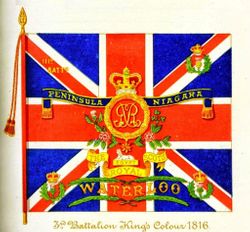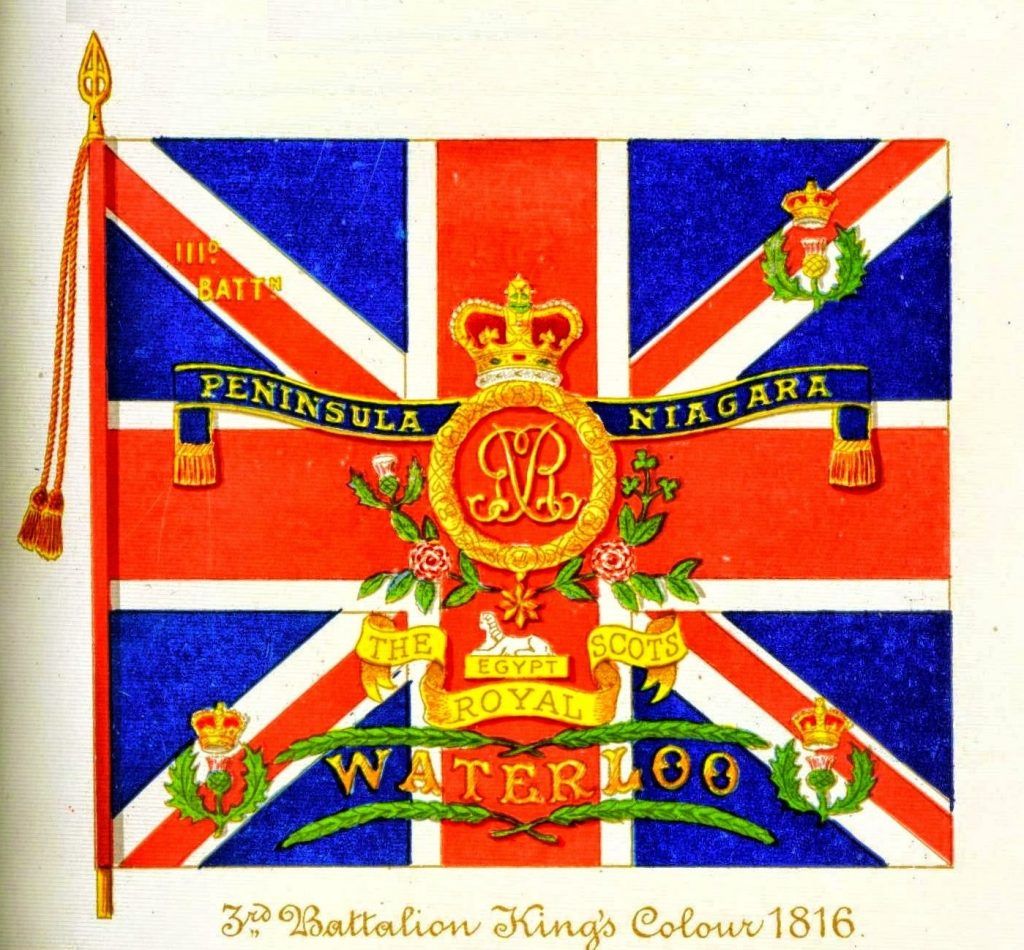A Military Knight of Windsor [not entitled to the prefix "Sir"]
Richard Blacklin, born in 1790, was the son of the Reverend Robert Blacklin, Master of the Grammar School at Heighington, County Durham. Some Army and census records state or imply 1796; possibly in later life he claimed to be 6 years younger than he actually was. His death registration gives his age as 71.
He was a Navy Midshipman before he joined the Militia in Ireland. He volunteered for Foreign Service following Napoleon's escape from Elba 26 Feb 1815. Armed with an introduction from HRH the Duke of Kent, he joined the 3rd Battalion at Fermoy Mar 1815. As his commission was dated 18 Jul, he fought at Waterloo as a Volunteer, in the Colour Party, in the thick of the fighting. In the early afternoon Pack's Brigade took the full force of the attack by 3 infantry Divisions of the French 1st Corps, 14,000 strong, commanded by D'Erlon.
Successive charges by heavily armed French cavalry forced the British regiments to form square, while under heavy fire from French artillery and tirailleurs. These assaults, together with the loss late afternoon of La Haye Sainte, left Wellington's forces in a critical condition. The arrival of the Prussians from the East relieved the pressure and Napoleon ordered the Garde Imperiale to attack Wellington's position. This attack, the only encounter between French and British Foot Guards in the Napoleonic Wars, was narrowly beaten off, and the headlong retreat of the French Guard "La Garde recule!" about 8pm, marked in effect the Allied victory.
Ensign Blacklin carried the King's Colour after 4 officers had been killed, and was himself wounded, apparently by a shell splinter in the shoulder. He was one of 5 officers out of 39 who marched with the Regiment to Paris, 34 having fallen, killed or wounded at the battles of Quatre Bras and Waterloo. Captain Macdonald, who took command after Major Colin Campbell was wounded, later wrote, "During the most trying part of the action, I particularly observed Lieut. Blacklin's activity and zealous exertions for the good of the Service".
Richard Blacklin remained in the Army after Waterloo and served with the Regiment in the Mahratta War of 1817-1819, leading storming parties at the captures of Nagpore and Asseerghur. He later served among other places at St Lucia and Gibraltar, and by 1839 was the last serving officer of the Regiment who had been at Waterloo. His last active posting was as a staff officer at Scutari in the Crimean War, and he was finally promoted to Colonel in 1858.
In 1865, he was appointed to the order of the Military Knights of Windsor, who reside in Windsor Castle and traditionally form the escort of the Knights of the Garter. The Military Knights are not members of the Order itself, nor are they automatically knights of any chivalric order.
He died in 1867 and was buried in St George's Chapel with full military honours on 22nd May 1867.
Richard Blacklin and his wife Margaret, some 25 years his junior, had seven sons and four daughters, some of whom died in childhood. Three of his sons, Robert, Richard, and Septimus followed careers in the Merchant Navy. One son, Frederick, followed him into the Army but died of yellow fever in Belize in 1868.
The Colours in question still exist, having been laid up after the battle in St Giles Cathedral, Edinburgh.
A Military Knight of Windsor [not entitled to the prefix "Sir"]
Richard Blacklin, born in 1790, was the son of the Reverend Robert Blacklin, Master of the Grammar School at Heighington, County Durham. Some Army and census records state or imply 1796; possibly in later life he claimed to be 6 years younger than he actually was. His death registration gives his age as 71.
He was a Navy Midshipman before he joined the Militia in Ireland. He volunteered for Foreign Service following Napoleon's escape from Elba 26 Feb 1815. Armed with an introduction from HRH the Duke of Kent, he joined the 3rd Battalion at Fermoy Mar 1815. As his commission was dated 18 Jul, he fought at Waterloo as a Volunteer, in the Colour Party, in the thick of the fighting. In the early afternoon Pack's Brigade took the full force of the attack by 3 infantry Divisions of the French 1st Corps, 14,000 strong, commanded by D'Erlon.
Successive charges by heavily armed French cavalry forced the British regiments to form square, while under heavy fire from French artillery and tirailleurs. These assaults, together with the loss late afternoon of La Haye Sainte, left Wellington's forces in a critical condition. The arrival of the Prussians from the East relieved the pressure and Napoleon ordered the Garde Imperiale to attack Wellington's position. This attack, the only encounter between French and British Foot Guards in the Napoleonic Wars, was narrowly beaten off, and the headlong retreat of the French Guard "La Garde recule!" about 8pm, marked in effect the Allied victory.
Ensign Blacklin carried the King's Colour after 4 officers had been killed, and was himself wounded, apparently by a shell splinter in the shoulder. He was one of 5 officers out of 39 who marched with the Regiment to Paris, 34 having fallen, killed or wounded at the battles of Quatre Bras and Waterloo. Captain Macdonald, who took command after Major Colin Campbell was wounded, later wrote, "During the most trying part of the action, I particularly observed Lieut. Blacklin's activity and zealous exertions for the good of the Service".
Richard Blacklin remained in the Army after Waterloo and served with the Regiment in the Mahratta War of 1817-1819, leading storming parties at the captures of Nagpore and Asseerghur. He later served among other places at St Lucia and Gibraltar, and by 1839 was the last serving officer of the Regiment who had been at Waterloo. His last active posting was as a staff officer at Scutari in the Crimean War, and he was finally promoted to Colonel in 1858.
In 1865, he was appointed to the order of the Military Knights of Windsor, who reside in Windsor Castle and traditionally form the escort of the Knights of the Garter. The Military Knights are not members of the Order itself, nor are they automatically knights of any chivalric order.
He died in 1867 and was buried in St George's Chapel with full military honours on 22nd May 1867.
Richard Blacklin and his wife Margaret, some 25 years his junior, had seven sons and four daughters, some of whom died in childhood. Three of his sons, Robert, Richard, and Septimus followed careers in the Merchant Navy. One son, Frederick, followed him into the Army but died of yellow fever in Belize in 1868.
The Colours in question still exist, having been laid up after the battle in St Giles Cathedral, Edinburgh.
Family Members
Advertisement
Advertisement










